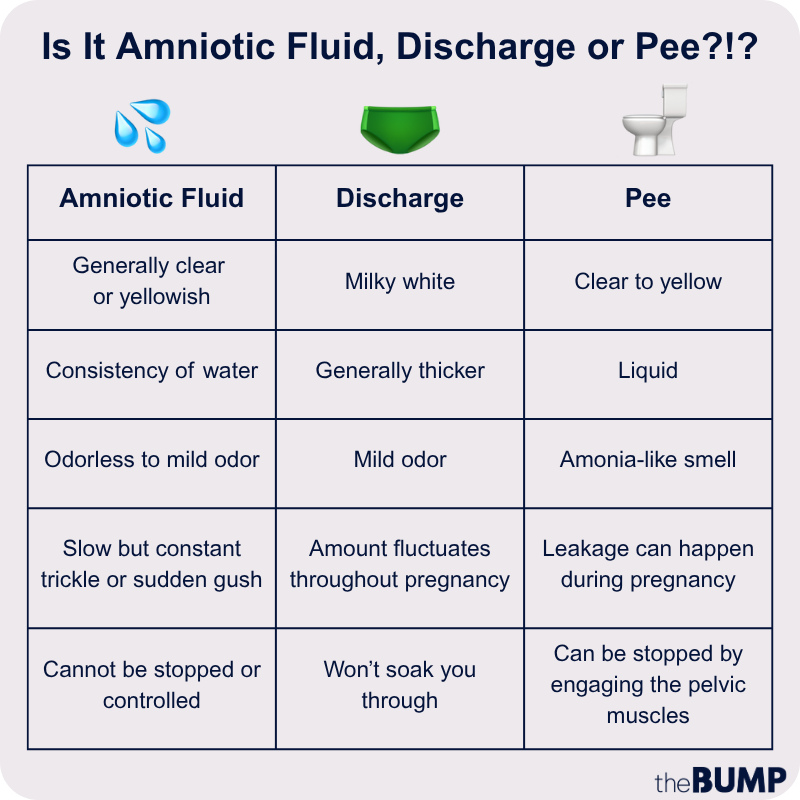Is It Discharge or More? How to Know if You’re Leaking Amniotic Fluid
You probably know what’s normal and what’s not when it comes to your own vaginal discharge. But pregnancy has a way of changing things up down there. Enter: confusion. If you notice more flow than usual, it’s fair to wonder about the signs of leaking amniotic fluid vs. discharge.
If you’re ever unsure or concerned that you may be leaking amniotic fluid, it’s important to check in with your healthcare provider. In the meantime, read up on what ob-gyns want you to know about the major signs of leaking amniotic fluid, plus important next steps.
Amniotic fluid is a clear-to-yellowish liquid that surrounds baby during pregnancy. It allows baby to grow inside the uterus, protecting them from injuries and fostering the exchange of body chemicals between Mom and baby. “Amnoitic fluid has the same density and consistency as water,” says Jonathan Schaffir, MD, an ob-gyn at the Ohio State University Wexner Medical Center.
If baby has a bowel movement, known as meconium, while in the womb, the amniotic fluid could have a slight greenish tinge, Schaffir says. “It’s also possible for the fluid to have a blood tinge, particularly during labor,” he adds.
There’s a range of what can happen if you leak amniotic fluid in pregnancy, explains Constants Adams, MD, an ob-gyn with Northwestern Obstetrics & Gynecology Consultants. “You may experience a sudden gush of fluid or even a slow trickle,” she says. “Regardless, I recommend you contact your provider for evaluation.”
Signs of leaking amniotic fluid vs. discharge
It’s normal to have more vaginal discharge than usual during pregnancy due to hormonal changes and increased blood flow to the vagina, says Eran Bornstein, MD, vice chair of obstetrics at Northwell Lenox Hill Hospital in New York.
There are a few key clues that’ll help you determine whether you’re dealing with discharge vs. amniotic fluid. “Normal discharge often has consistency (mucus) vs. amniotic fluid, which is more like water,” Adams says. Typical discharge also may be white or milky with a mild odor or no smell at all, Bornstein says. “In contrast, leaking of amniotic fluid is watery, clear and continuous in most cases.”
G. Thomas Ruiz, MD, lead ob-gyn at MemorialCare Orange Coast Medical Center in Fountain Valley, California, notes that “most of the time, it’s pretty easy to tell the difference. Amniotic fluid [often] comes out in a gush.” He adds, “It floods and doesn’t stop.”
It’s also possible to confuse amniotic fluid with a urine leak. But, “unlike urine, where the stream can be stopped by contracting the muscles of the pelvic floor, the flow of amniotic fluid cannot be stopped,” notes Schaffir.
There are a few reasons why you might leak amniotic fluid. Most of the time, if you’re leaking amniotic fluid, it means labor has started, notes Schaffir. “Contractions of the uterus cause the cervix to start to thin out and dilate, creating a shear force on the membrane that makes /[the amniotic sac] rip,” he says. However, he notes that only about 10 percent of expectant moms will actually feel their water break.
Occasionally, the membranes can also tear when baby is preterm, Schaffir adds. That can happen due to an infection, trauma to the abdomen or having a short cervix.
I was sitting in bed with my husband planning out our weekend (I was so excited to go buy a new pair of boots!), when I suddenly felt a little trickle drop down there. I got up and ran to the bathroom and was confused by the drip-drip-drip that wouldn’t stop even after I fully emptied my bladder. ‘Hmmmm, do you think we should call the doctor?,’ I asked my husband. Cue: a veritable flood of fluid. ‘Oh, yeah. Time to call the doctor!’
If you think you’re leaking amniotic fluid, it’s important to reach out to your provider right away.
The amniotic membrane is a barrier between the cervix (the lower, narrow end of the uterus) and vagina where bacteria grow, and the sterile sac where baby grows, explains Schaffir. So, when it breaks, there’s a risk of infection. “Rarely, the umbilical cord can get squeezed after the fluid leaks out, so it’s also important to be checked to make sure [baby] is still getting good blood flow,” he says.
In the meantime, while you’re waiting to be checked out, you can put a pad in your underwear, but don’t insert anything into your vagina.
Your doctor may take a swab of the fluid to analyze it and determine whether it’s amniotic fluid or discharge, Bornstein says. This may involve using pH paper to learn about the acidity of the fluid, explains Ruiz. “Amniotic fluid is very basic,” he says. “If the paper turns blue, there’s a good chance you’ve ruptured.” It’s likely that you’ll also have an ultrasound to see how much amniotic fluid surrounds baby.
Unfortunately, there’s no way to reseal a break in the amniotic membrane, Schaffir points out. If you’re close to your due date but your cervix is closed, Ruiz says your doctor will likely want to induce labor. But if you’re before 34 weeks in your pregnancy—which is considered preterm—your doctor may recommend that you go on bed rest and take antibiotics. “We’ll try to keep baby in as long as possible,” he says. If you develop signs of infection or progress beyond 34 to 35 weeks, your doctor will likely schedule an induction.
International Journal of Reproductive BioMedicine, Amniotic fluid characteristics and its application in stem cell therapy: A review, September 2022
Science Direct, Amniotic Fluid Index(https://www.sciencedirect.com/topics/medicine-and-dentistry/amniotic-fluid-index#:~:text=The%20AFI%20is%20normally%207,(too%20much%20amniotic%20fluid), 2018
Eran Bornstein, MD, is vice chair of obstetrics at Northwell Lenox Hill Hospital in New York. He earned his medical degree from the Sackler School of Medicine at Tel Aviv University.
Constants Adams, MD, is an ob-gyn with Northwestern Obstetrics & Gynecology Consultants. She earned her medical degree from the Medical University of South Carolina College of Medicine.
G. Thomas Ruiz, MD, is the lead ob-gyn at MemorialCare Orange Coast Medical Center in Fountain Valley in California He earned his medical degree from UC Irvine School of Medicine.
Jonathan Schaffir, MD, is an ob-gyn at the Ohio State University Wexner Medical Center. He earned his medical degree from Brown University in Providence, Rhode Island.
Learn how we ensure the accuracy of our content through our editorial and medical review process.
Navigate forward to interact with the calendar and select a date. Press the question mark key to get the keyboard shortcuts for changing dates.






















































